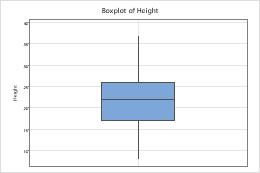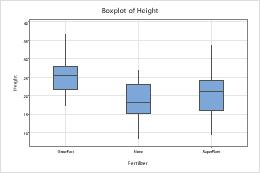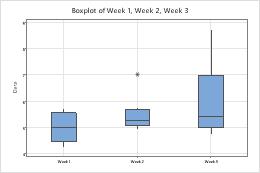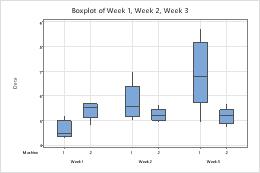One Y: Simple
Create a boxplot that displays the distribution of values for one variable. The worksheet must include at least one column of numeric or date/time data.
For example, in the following worksheet, Height contains the numeric data. The graph shows the distribution of heights.
| C1 |
|---|
| Height |
| 22 |
| 26 |
| 19 |
| ... |

For more information, go to Create a boxplot of one Y variable.
One Y: With Groups
Create a boxplot that displays the distributions of values for different groups. The worksheet must include at least one column of numeric or date/time data and at least one column of categorical data. Groups are defined by values in the categorical variable, or by unique combinations of values in multiple categorical variables.
For example, in the following worksheet, Height contains the numeric data and Fertilizer contains the categorical data. The graph shows the distributions of heights for each fertilizer group.
| C1 | C2-T |
|---|---|
| Height | Fertilizer |
| 22 | None |
| 26 | GrowFast |
| 19 | SuperPlant |
| ... | ... |

For more information, go to Create a boxplot of one Y variable with groups.
Multiple Y’s: Simple
Create a boxplot that displays the distribution of values for different groups. The worksheet must include multiple columns of numeric or date/time data. Each column is a group.
For example, the following worksheet contains the diameters of pipes produced each week for three weeks. Week 1, Week 2, and Week 3 contain the numeric data. The graph shows the distribution of pipe diameters for each week.
| C1 | C2 | C3 |
|---|---|---|
| Week 1 | Week 2 | Week 3 |
| 5.19 | 5.57 | 8.73 |
| 5.53 | 5.11 | 5.01 |
| 4.78 | 5.76 | 7.59 |
| ... | ... | ... |

For more information, go to Create a boxplot of multiple Y variables.
Multiple Y’s: With Groups
Create a boxplot that displays the distribution of values for multiple-level groups. Multiple-level groups are displayed as clustered boxes. The worksheet must include multiple columns of numeric or date/time data and at least one column of categorical data. Groups are defined by separate columns and by values or unique combinations of values in categorical variables.
For example, the following worksheet contains the diameters of pipes produced each week for three weeks, on two machines. Week 1, Week 2, and Week 3 contain the numeric data. Machine contains the categorical data. The graph shows the distribution of pipe diameters for each week and for each machine.
| C1 | C2 | C3 | C4 |
|---|---|---|---|
| Week 1 | Week 2 | Week 3 | Machine |
| 5.19 | 5.57 | 8.73 | 1 |
| 5.53 | 5.11 | 5.01 | 2 |
| 4.78 | 5.76 | 7.59 | 1 |
| ... | ... | ... | ... |

For more information, go to Create a boxplot of multiple Y variables with groups.
